
Where the seabirds go
During winter, dozens of seabird species take flight from New Zealand on epic migrations across the planet—and recent advances in tracking technology mean we can now follow them. What we’re learning has upended scientists’ ideas about the lengths animals will go to in order to raise a family.

“Sooty shearwater, 10 o’clock!” calls Paul Sagar.“Mottled petrel, three o’clock,” replies Alan Tennyson.
The sea is calm and glassy, and I’m straining to pick out the small birds skimming across its silvery surface. I’m on board the yacht Evohe with a team of ornithologists, en route to the Bounty Islands, 670 kilometres southeast of New Zealand.
“It’s hard to believe something so small and delicate can survive out here,” says Tennyson, vertebrate curator at Te Papa, noting the sighting in his book.
As he and NIWA scientist Sagar trade observations, I’m dazzled by the array of names: mottled, white-capped, diving, sooty. Petrels, prions, shearwaters. There are so many species in this empty stretch of ocean that I’ve never even heard of. Out here, far beyond the coastline, vast armies of birds are at work, seen only by the boats and fishing vessels with which they share the richest corners of the sea.

New Zealand is, by a clear margin, the seabird capital of the world. Every summer, 14 species of albatross and more than 70 different petrels, gannets, shags, terns, gulls, shearwaters, penguins and prions raise their young within our territorial limits. We have the most endemic species of any country in the world, by far. Most New Zealanders, however, would recognise only a few.
“They’re often on remote oceanic islands where no one’s even heard of the island, let alone the birds that breed on it,” says Graeme Taylor, a Department of Conservation (DOC) principal science adviser.
Places like the Bounty Islands—sere granite stacks devoid of vegetation, their entire surface peppered with tens of thousands of seabirds. These 22 rock stacks, just 135 hectares in area, are the world’s main breeding ground for Salvin’s albatrosses and erect-crested penguins.
[Chapter Break]
By dawn the following day, we’re in the islands’ lee. The cliffs stream with guano, the acrid smell wafting across our boat as it wallows in the confused swell between the islands. Our boots, packs and clothing have been thoroughly cleaned and sanitised to make sure we don’t introduce weeds, and to protect the islands’ inhabitants from disease.
We nose the inflatable tender into a nook on the side of Proclamation Island. This small natural step is the only safe access. We clamber out of the boat and climb up the island’s side, hauling ourselves up a fixed rope at the steepest point and startling a pair of Bounty Island shags preening on a rock ledge. Identifiable by their striking red eyepatches, these shags breed only here. They glare at us as though unsure how to react.
We gain the top of the island, and we’re amid a mass of nesting birds. It’s impossible to move in any direction without needing to step around an albatross or a penguin.

Every minute we spend here, I feel more and more clumsy and intrusive. This is no place for humans.
Amid the crush of birds, fur seals slumber or play-fight with each other. Tiny grey-blue fulmar prions hide from the wind in nooks in the rocks. Pairs of erect-crested penguins huddle over their eggs, their bold yellow eyebrows ruffled by the gusty breeze. As we pass, they shriek and snap at our trouser legs.
Salvin’s albatrosses—shockingly handsome with their fine grey head plumage, sculpted beaks and black eyeliner—perch on nests painstakingly crafted from the island’s sparse mud. In this world of bare rock, nest-building materials are at a premium. Salvin’s albatrosses will use anything, including the bones of their recently deceased brethren, to reinforce their constructions.
As we gingerly move through the menagerie, the big birds shuffle nervously on their nests, briefly revealing ivory-coloured eggs beneath their downy breasts. Occasionally, they stand up to stretch, unfurling the full 2.5-metre span of their wings. The sky above is thick with albatrosses, which loop in with sublime grace only to land with all the delicacy of a bag of golf clubs.
Like most of New Zealand’s seabirds, Salvin’s albatrosses form pairs through the summer to raise their chicks. While nesting, they take turns to forage on the Chatham Rise and up the east coast of New Zealand, gathering food for themselves and their chicks. Once the chicks have fledged, the parents make much longer journeys, seeking out rich food sources off the coast of South America to fatten up for the next breeding season.
Where they go, danger awaits. Fishing vessels drop kilometre-long lines of hooks into the depths. Albatrosses and other seabirds are attracted to the bait, and occasionally get hooked, drowning as the line runs out from the ship. Seabirds also frequently get caught up in trawl gear and nets. (Between 3000 and 14,000 seabirds are killed in New Zealand fisheries every year.)
Salvin’s albatrosses are now critically endangered, with their breeding population believed to be in serious decline.

Attaching tracking devices to these birds will provide DOC and the Ministry for Primary Industries (MPI) with detailed information about their movements.
“When we know where the birds are going,” says Graham Parker, who is co-leading the expedition with his partner, Kalinka Rexer-Huber, “we can quantify the risk of a given fishery to these birds, and then look to make sure there’s adequate mitigation in that fishery so that they’re reducing their seabird bycatch as much as possible.”
Parker and Rexer-Huber also hope to learn whether the birds are venturing into very polluted parts of the ocean, areas of oceanic warming, or places where toxic algal blooms are occurring.
The first task is to retrieve the tracking devices the team deployed here last year. Albatrosses are faithful to their breeding sites—although these birds have travelled all the way across the Pacific in the past six months, they’ve returned to breed on the same tennis-court-sized patch of rock as last year.
Rexer-Huber and I pick our way through the mob, looking for birds with trackers attached to their legs. When we find one, Rexer-Huber plucks the bird from its nest and holds it while I snip off the SIM-card-sized device. Bracing myself against the wind, I clutch the tiny tracker tightly in my hand, terrified of dropping it into a crack in the granite beneath our feet.
Each one of these GLS trackers holds a year’s worth of unsaved data—it records sunrise and sunset times to calculate latitude, daylight hours to determine longitude, and water temperature, which helps narrow down where on the planet it is. These are all measurements that 18th-century sailors used to make.
The trackers cost about $400 each. Since they use very little power, they can stay active for years, positioning albatrosses to within a couple of hundred kilometres of their location. But this margin of error means researchers can’t identify exactly where or when an albatross crosses paths with a fishing vessel. In order to collect more detailed data, a more sophisticated device is required.
GPS trackers are accurate to within a few metres and transmit information to satellites, meaning the birds can be followed in real time. They’re also far more expensive, at anywhere from $4000 to $6500. I watch Parker, Rexer-Huber and Sagar attach GPS trackers to 12 nesting birds. After a bird is plucked from its nest, a specialised egg-warmer (Parker’s woollen hat) is put in place to stop the egg chilling in the bitter wind. The transmitter is then glued to a plastic saddle mounted on the bird’s back. Once it’s all in place, the ruffled albatross clambers back onto its nest.

It takes a good half hour to mount a tracker on each albatross, and the team must regularly suspend work to avoid the frequent rain squalls, as water will stop the glue from setting.
These GPS trackers will continue transmitting for several months before their batteries run out, explains Sagar, a subantarctic seabird veteran with decades of albatross research behind him. “If you want really detailed information on the location of the bird, you have the signals going out much more frequently, but the more points you’ve got, the more battery is used.” The fancier models, he says, have solar panels that keep them running much longer.
These transmitters don’t need to be collected later by scientists. They will fall off the albatrosses naturally within a year, when the birds moult—but, by that time, researchers will have already followed their passage across the ocean.
[Chapter Break]
Trackers used to be too large and heavy for most seabird species to carry. That’s all changed in the past two decades.
“We already knew that seabirds went a long way,” says Auckland Museum ornithologist Matt Rayner. “But the scale of their everyday life has just opened scientists’ eyes.”
In 2006, a study led by Scott Shaffer from the University of California, Santa Cruz, attached GLS trackers to 19 sooty shearwaters, or tītī. These brown kererū-sized birds lay eggs and raise chicks in burrows. During the breeding season, they form huge colonies on predator-free islands around New Zealand, and at certain times of year can be seen moving up the coasts in flocks, skimming the ocean surface with their wingtips as they search for food.
The trackers revealed these birds were making 64,000-kilometre migrations into the North Pacific. At the time, these were the longest animal journeys ever tracked electronically. (That honour has since been claimed by the Arctic tern, which in 2010 was recorded travelling 71,000 kilometres between the Arctic and the Antarctic.) Since then, numerous other New Zealand seabird species have been found to make similar migrations.
“Every time we put [trackers] onto a different species,” says Taylor, “what we discover pretty much blows us away.”
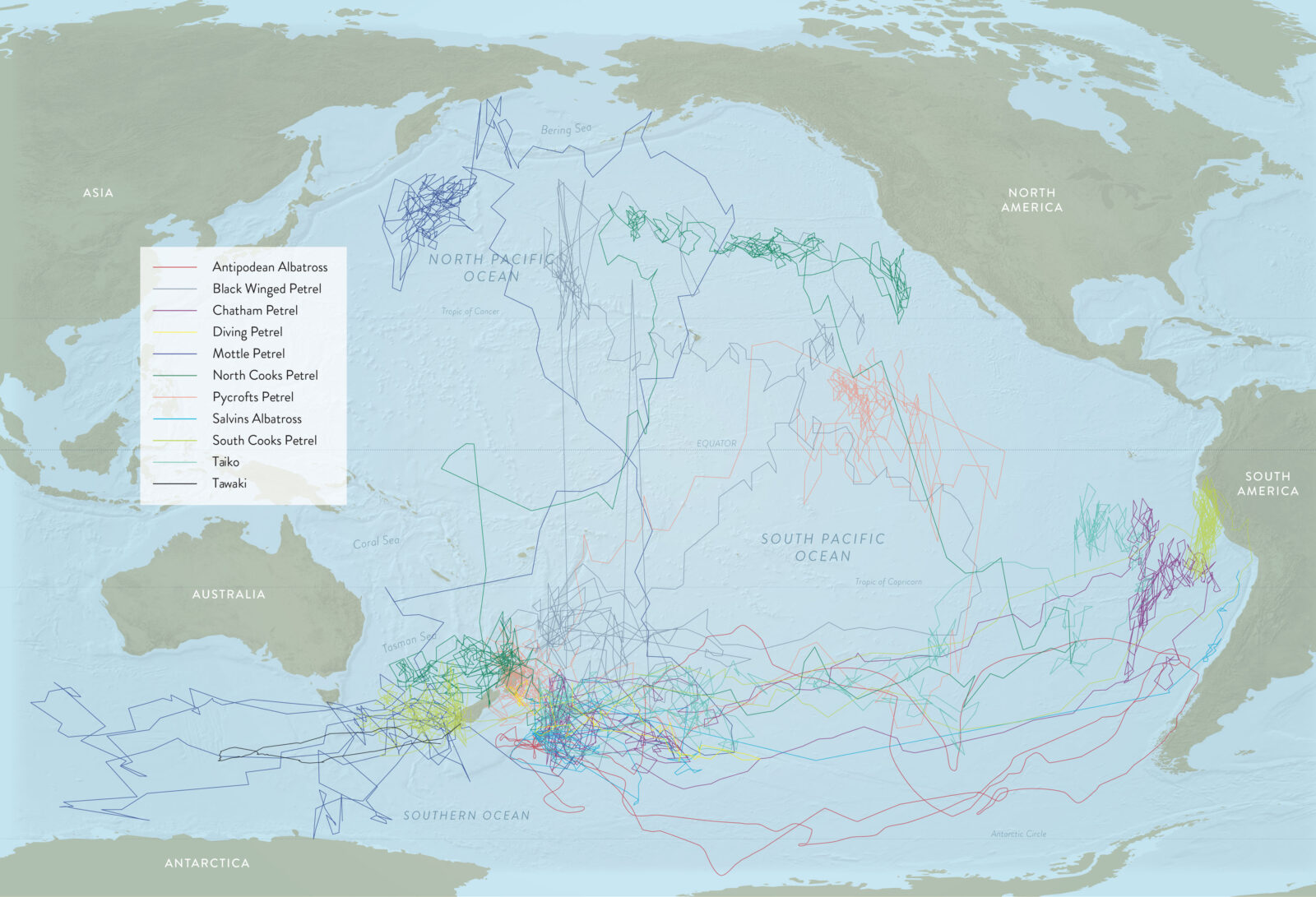
The more data we gather, the more remarkable these journeys appear.
At the end of summer, seabirds head to particularly rich regions of the Pacific—areas called “fronts”, where water masses meet, causing upwellings that bring nutrients such as nitrogen and phosphorus to the surface. These hyper-fertile waters are rich in phytoplankton, the foundation of the food chain. Here, massive numbers of fish, birds and whales converge to feed on smaller creatures.
“Cook’s petrels, Pycroft’s petrels and black-winged petrels, and all the different shearwaters, are all going to different areas of the North Pacific,” says Chris Gaskin of the Northern New Zealand Seabird Trust. He has played a key role in many seabird studies. “It’s been quite a neat outcome, looking at how birds partition out the oceans.”
It’s as if seabirds have divided the Pacific into feeding patches, with each species returning to its own clearly delineated territory at the end of the summer.
Even within species, big differences in foraging patterns are emerging. Tītī from Te Hauturu-o-Toi/Little Barrier Island, near Auckland, head to the northern hemisphere, stopping off around Hawaii or California, while tītī from Whenua Hou/Codfish Island, off the coast of Rakiura/Stewart Island, fly to the eastern Pacific, never crossing the equator.
“So the southern birds are holding an ancestral memory that’s completely different from the northern birds,” says Taylor. (This discovery has led to speculation that these populations may also be genetically distinct.)
New Zealand’s seabirds forage in their separate corners of the globe for up to eight months. When spring returns to the southern hemisphere, the urge to breed returns, and the birds begin the long trek home. Usually, they return to the same nest they used the previous year, often to mate with the same partner.
“Somewhere in their brain,” says Taylor, “they know they have to be back at a certain time. They have to plan their flights coming from a long, long way, against all the vagaries of the weather.
“But the pairs, in general, arrive back within a day or two of each other, often on the same night.”
[Chapter Break]
A hundred kilometres north of Auckland, perched on the edge of the continental shelf, is a small collection of rugged volcanic islands: the Mokohinau group. These islands have long been known as a seabird stronghold, and Māori visited them to harvest the chicks of grey-faced petrels, or ōi. An activity known as “muttonbirding”, gathering plump seabird chicks from their burrows, has been an important source of food throughout Māori history. Today, Ngāti Wai retain the right to muttonbird on the Mokohinau Islands, while Ngāi Tahu gather tītī chicks from islands around Rakiura/Stewart Island.
The Mokohinau Islands are also home to common diving petrels, or kuaka. These burrowing seabirds with short wings and blue feet aren’t much larger than tūī, and forage nearby in the Hauraki Gulf. In 2010, a group of seabird scientists attached GLS trackers to 12 birds to trace their migrations for the first time. In the hut the scientists were staying in there was a blackboard, and on it they drew a map of New Zealand, then guessed where the birds were going.
“The theory,” says Taylor, “was that they finish breeding and then disappear out to deeper water to moult, then come back. We were expecting them to just stay up around northern New Zealand.”
Once the first lot of data was downloaded, the team had to quickly redraw their map.
“The birds were going right down into the Antarctic polar front and two-thirds of the way to Chile,” says Gaskin.

black petrel attacks a piece of bait on a mock fishing line. Black petrels, once the most important muttonbird species for North Island Māori, are now restricted to just two nesting sites in the Hauraki Gulf. Of all New Zealand seabirds, they are considered to be most at risk of becoming bycatch.
The Antarctic polar front, where subantarctic waters meet the colder, northward-flowing waters from Antarctica, is one of the most food-rich parts of the planet’s oceans. Packed with krill and small fish, it’s a smorgasbord for any bird capable of making the trek. The fact that diving petrels could go the distance astonished scientists.
“For a bird that fits in the palm of your hand, heading down to the polar front—that’s just phenomenal,” says Gaskin. “What was remarkable was the time that these birds were taking to get there. It was just a matter of days.
“If you’ve seen diving petrels flying, well, you could argue they’re aerodynamically challenged. They’re essentially a flying penguin, with little wings. But these guys were really going for it.”
Other small seabirds also travel at blistering speeds.
“Cook’s petrels can reach their North Pacific wintering ground in 12 to 14 days,” says Rayner. “Sooties can do it in less.”
[Chapter Break]
Not all migrating birds fly. There are other, equally impressive migrations happening in the water.
Penguins may not look like endurance athletes, but Snares crested penguins have been recorded travelling thousands of kilometres to waters south of Tasmania to feed up in the rich subantarctic front. Rockhopper penguins from Campbell Island head in the opposite direction, travelling south-east towards the Antarctic polar front. Some of these penguins cover more than 15,000 kilometres each winter.
Thomas Mattern of the NZ Penguin Initiative has done extensive tracking work on hoiho (yellow-eyed penguins) and tawaki (Fiordland crested penguins). While hoiho are sedentary, staying at home all year round, tawaki are the opposite. Once they’ve raised their chicks in the rainforests of Fiordland or Westland, tawaki swim to the subtropical and subantarctic fronts south of Australia, covering distances of up to 6800 kilometres. It’s the longest recorded migration of any penguin—and they do it not once, but twice a year.
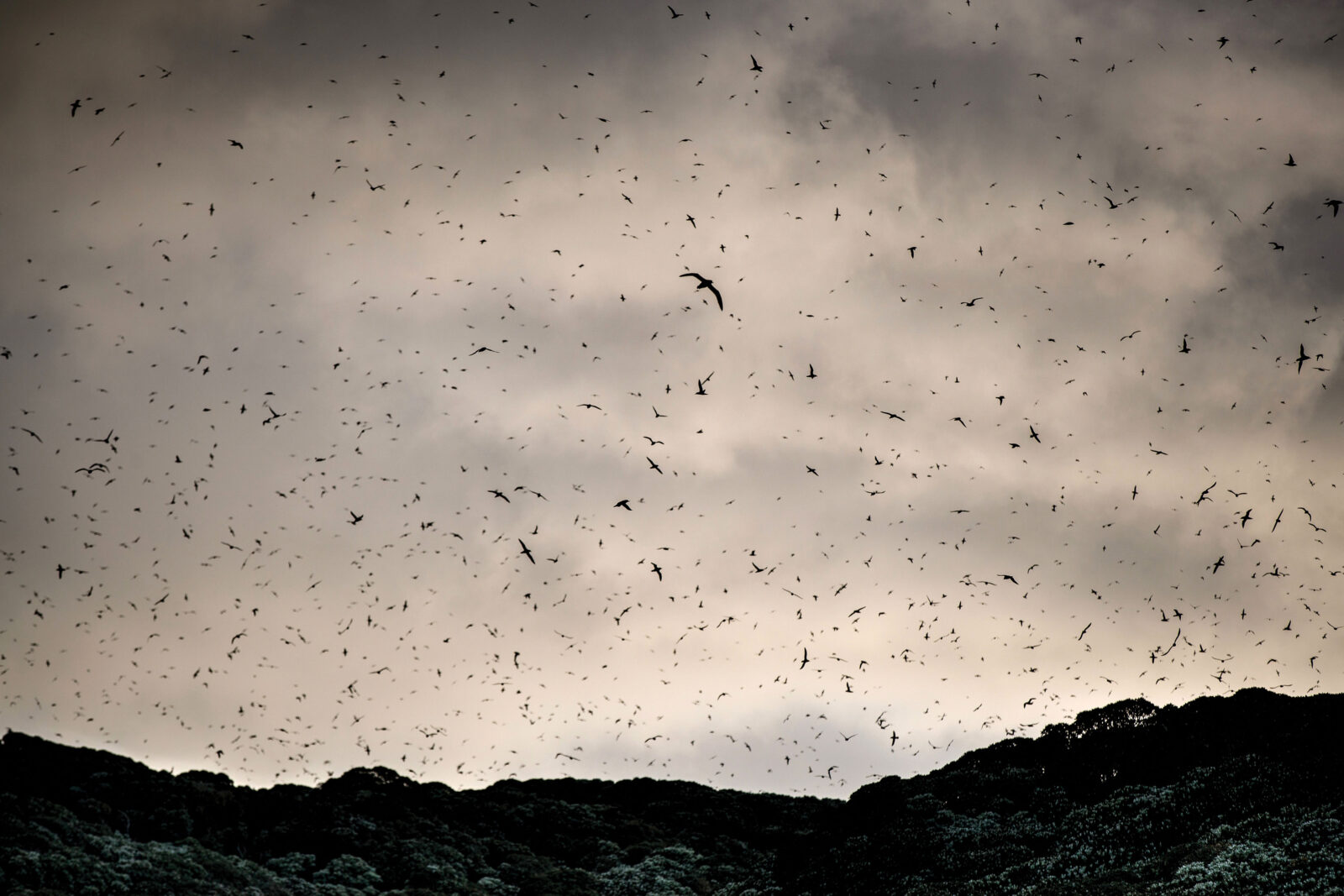
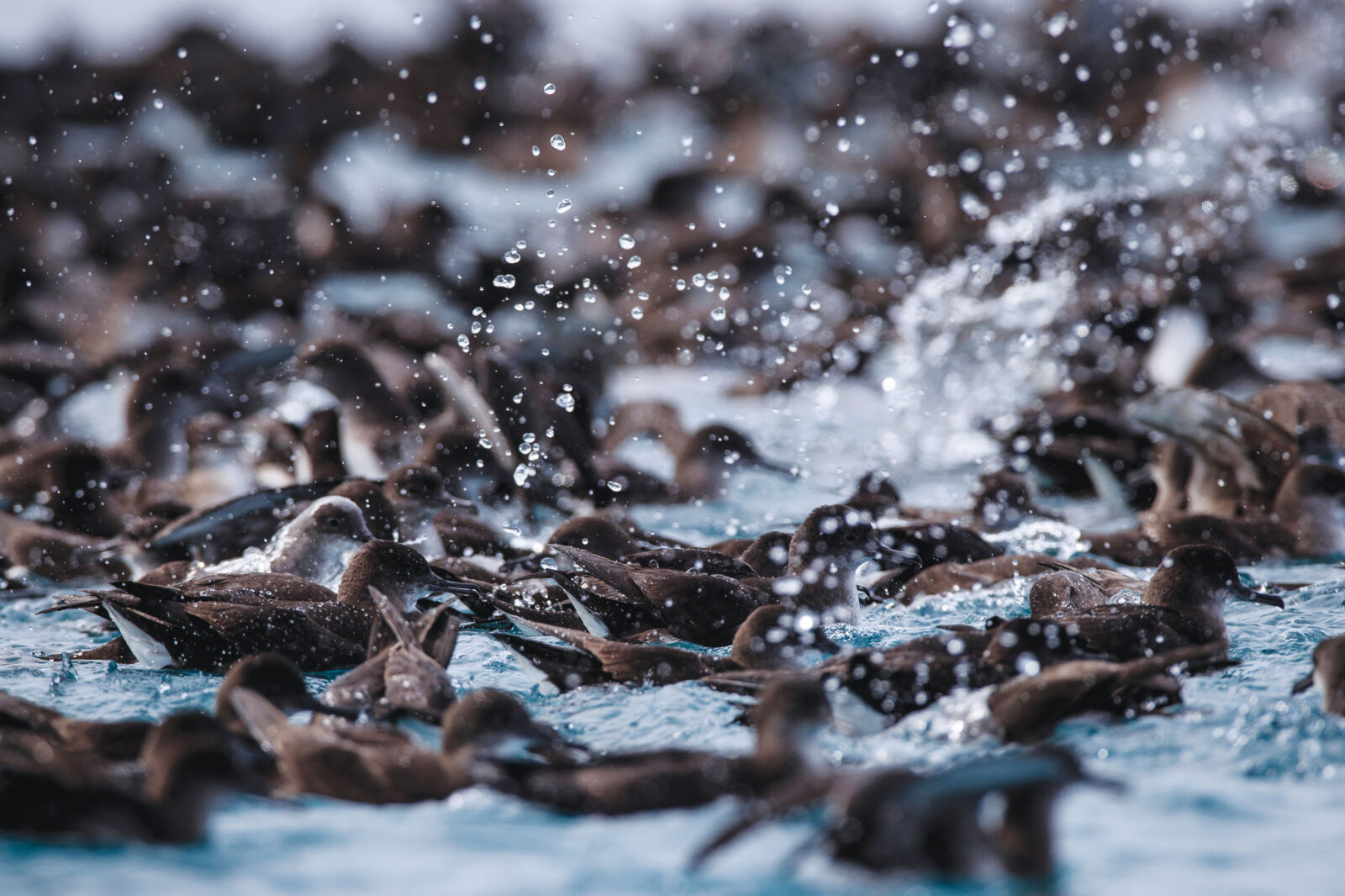
After breeding, they disappear for eight to ten weeks, then return to moult, a long process during which they can’t feed in the ocean. (Without feathers, penguins aren’t waterproof.) Then, once they’ve finished growing new feathers, tawaki do it all again, returning to the same waters along the subantarctic front to fatten up.
“They’re travelling up to 1000 kilometres a week,” says Mattern. “It’s just completely insane.”
What makes it especially bizarre is that these migrations appear to be utterly pointless, as there is plenty of food around mainland New Zealand to support their population. Mattern believes it’s possible the birds are simply responding to genetic memory. (His penguin tracking data can be followed online on the Tawaki Project website.)
While the length of their journey is extraordinary, it’s what the penguins do along the way that most interests Mattern.
“We’re effectively using seabirds as probes to understand what is happening out in the oceans,” he explains. “Seabirds can be our bio-loggers, so to speak, to figure out how the oceans are changing, because when the seabirds have to change their movement patterns over time, that also tells us how ecosystems are shifting in the ocean. So, by tracking seabirds, we can learn a lot about the state of things in the oceans.”
A 2009 study led by Fabien Roquet of Stockholm University attached satellite-transmitting devices measuring ocean salinity and temperature to elephant seals in the southern Indian Ocean. The devices recorded the seals’ long foraging trips as they plunged up to two kilometres below the surface in search of food. The amount of oceanographic data they recovered was unprecedented.
“They got this huge area covered in measurements that you could never cover with a research vessel,” says Mattern. “But, of course, elephant seals still have a fairly limited range. As these devices get smaller, I can promise you that diving seabird species like petrels and penguins are going to be our number-one oceanographic probes in the future.
“That’s why I think it’s so important that we maintain tracking studies. It’s not so much just to understand the specific behaviour of a species, but rather they can become ocean probes that deliver essential data for us to model what’s happening with the planet.”
[Chapter Break]
On Te Hauturu-o-Toi/Little Barrier Island, the ground is so densely riddled with seabird burrows that, in places, it’s impossible to walk without falling into one. One summer evening, I climb to a high ridge on the island, and listen in the dark as thousands of Cook’s petrels return to their nests, crashing into the foliage—and occasionally into me.
Adult petrels forage at sea during the day, then return to their nests at night. The cacophony of their chattering is like the frantic hubbub of an urban railway station. Somewhere in the din, I can hear the low booming of a male kākāpō. The lights of Auckland glow faintly in the distance. It’s astonishing to me that I’m experiencing all of this so close to New Zealand’s biggest city.
There are around two million Cook’s petrels on Te Hauturu-o-Toi, but their population was once many, many times larger than that. Their bones are found in the subfossil record the length of New Zealand. Along with vast numbers of other seabirds, they bred in the tens of millions around the country before humans arrived, and their droppings would have nourished the places where they lived.

“The mountains of New Zealand would have had colonies spread all across them,” says Taylor. “You would have had huge numbers going inland at night, dropping nutrients right across the landscape, and, of course, all those nutrients would have been hugely important for the bush down below.”
These guano deposits likely also aided early agriculture. Today, farmers dump imported phosphate onto mineral-deficient soils that would once have been naturally fertilised by bird droppings.
And the birds would have also been important for the Pacific. At certain times of the year, skies above the Pacific islands would have darkened with enormous clouds of petrels and shearwaters returning to Aotearoa to breed. Their migrations may even have led the first Polynesian explorers to New Zealand—it’s thought those early navigators followed the birds south.

Today, however, introduced predators have almost completely wiped out the seabird colonies on mainland New Zealand, but there are a few left. Hutton’s shearwaters breed in large numbers in the inland Kaikōura mountains, while the world’s entire population of Westland petrels raise their young in broadleaf forest near Punakaiki on the West Coast. Grey-faced petrels are making a comeback to pockets around the top of the North Island, and new mainland tītī colonies have recently been noticed in the south.
But our remaining seabird strongholds are all on predator-free islands, especially in the subantarctic. There, a glimpse of what was lost can still be found.
[Chapter Break]
“If I step outside the hut, there’s a cacophony of petrels,” DOC scientist Graeme Elliott tells me, speaking via satellite phone from the Antipodes Islands, 900 kilometres south-east of New Zealand. “You come to a place like this, and you realise this is how New Zealand used to be.”
Elliott and his partner, Kath Walker, have been visiting this realm most years since 1989, and have spent much of that time studying the wandering albatross species of the Auckland and Antipodes islands. Wandering albatrosses are famous travellers, known to circumnavigate the globe three times a year. Two species stop in New Zealand: Gibson’s albatrosses on the Auckland Islands, and Antipodean albatrosses on the islands whose name they share. Elliott and Walker’s tracking work has shown that, while these two species are very closely related, they have different foraging habits.
“The Gibson’s go as far west as Perth, all around the Tasman sea, and up to the top of New Zealand,” says Elliott. “Whereas the Antipodes ones feed on the Chatham Rise, and then go all the way across to the coast of South America. They’ve clearly divvied up the ocean to suit themselves.”
[sidebar-1]
Elliott and Walker tracked one male Antipodean albatross travelling as far as South America during the breeding season. His nest partner sat incubating the eggs, unable to feed, becoming more dehydrated with every passing day. Four weeks later, the male returned to take his turn sitting on the egg, finally allowing his mate to fly off and find food.
“She was a hanger-on-er,” says Elliott.
Since he and Walker began counting Antipodean albatrosses 30 years ago, the bird population has been falling at around seven per cent per year, with females in the faster decline.
Tracking data shows that, for reasons unknown, females are now travelling much further than they used to. They used to forage around New Zealand after the breeding season, but now they’re crossing the Pacific to South America, where it is thought they are encountering fishing fleets.
“On the open sea, there’s bugger all policing, so fishermen probably don’t use mitigation techniques,” says Elliott. “We suspect most of the decline is being caused by birds being caught outside of the New Zealand and Australian exclusive economic zones.”
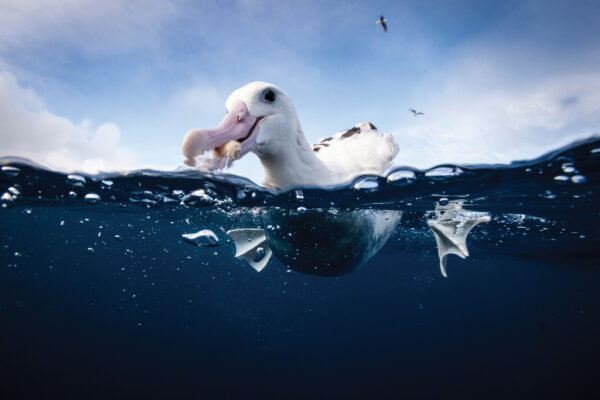
It’s well known that longlining and trawling kill albatrosses, but gathering evidence about where it’s happening and who’s responsible can be difficult. On numerous occasions, Elliott and Walker have tracked albatrosses that came within the vicinity of fishing boats an hour or two before their satellite feed cut out, never to return. In one instance, Elliott and Walker watched as a tracker bore down on a fishing boat in the Pacific. “We saw the two converge and then they tracked off together, which meant the transmitter was now on the boat,” says Elliott.
The tracker was eventually retrieved from a fishing vessel in Fiji.
Now, tracking technology includes radar detection, which allows trackers to detect fishing boats and intercept a vessel’s automatic identification signal. Could foraging albatrosses monitor illegal fishing activity? Elliott is hesitant to suggest so.
“If I was a fisherman and I thought all the albatrosses were carrying tags that were recording what I was doing,” he tells me, “I might be inclined to shoot them.”
[Chapter Break]
Summer is long over, and in the wildest reaches of our oceans millions of seabirds are making their annual migrations around the globe. At home, I watch on DOC’s online albatross tracker the progress of the Salvin’s albatrosses we tagged on the Bounty Islands back in October. As this issue goes to print, half the birds we tagged have crossed the eastern Pacific and are flying northwards up the coast of Chile.
My hometown of Dunedin famously has the world’s only mainland albatross colony—the northern royal albatross colony at Taiaroa Head—but there are more inconspicuous seabirds breeding within the city limits, too.
On a breezy Otago day, I wander the clifftops of the coastal suburb of Saint Clair, the Pacific stretching out before me. I find conservationist Graeme Loh at work inside a predator-proof fence he fundraised to build in 2013. Loh lives just a few blocks away, and the fence protects a small colony of fairy prions.
“Fairy prions are the lab rats of seabirds,” he says. “You can handle them without disturbing them. I can hold an incubating fairy prion in my open hand, and it’ll just sit there. So I’m able to study them really easily.”
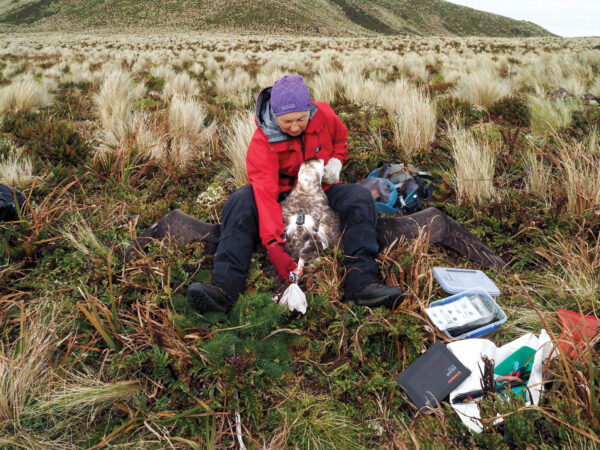
These tiny blue-grey birds are widespread around the Southern Ocean. They’re not considered threatened, but Loh doesn’t want to lose them from the fringes of Dunedin. He and his team of volunteers have installed nest boxes inside the fence, and Loh’s hope—yet unfulfilled—is that the birds will start breeding in this grassy area where locals can catch a glimpse of them, rather than within the inaccessible cliffs below.
Last year, Loh had a go at GLS tracking the birds after they’d finished breeding. “I was the first person to put geolocators on fairy prions,” he tells me. “I thought, ‘This is not going to work.’ It was the equivalent of putting a suitcase on a human’s leg. But I got 100 per cent return on 15 trackers.”
To his surprise, it turned out that the tiny prions, like many other New Zealand seabirds, were heading south and east to the Antarctic polar front. Fascinating enough, but Loh’s main priority is showing New Zealanders the incredible diversity of the seabirds we share the land and the ocean with.
“Most people just don’t appreciate them,” he tells me, as he packs up his tools and heads for home. “It’s a real feature of New Zealand. I’ve seen 58 species of seabird off the Otago Peninsula. I just want people to be more aware of this wealth we have.”

















